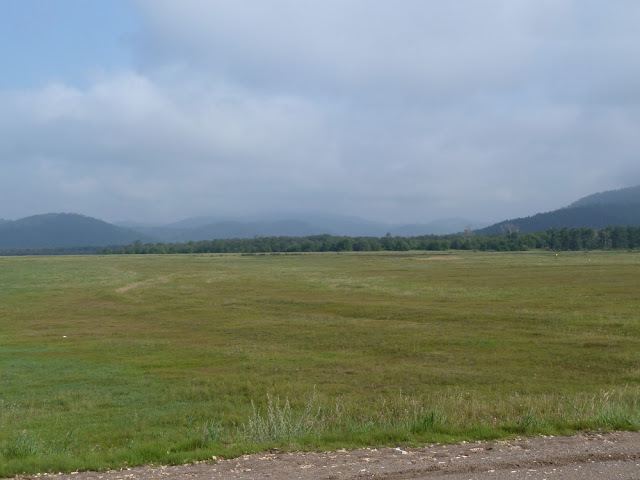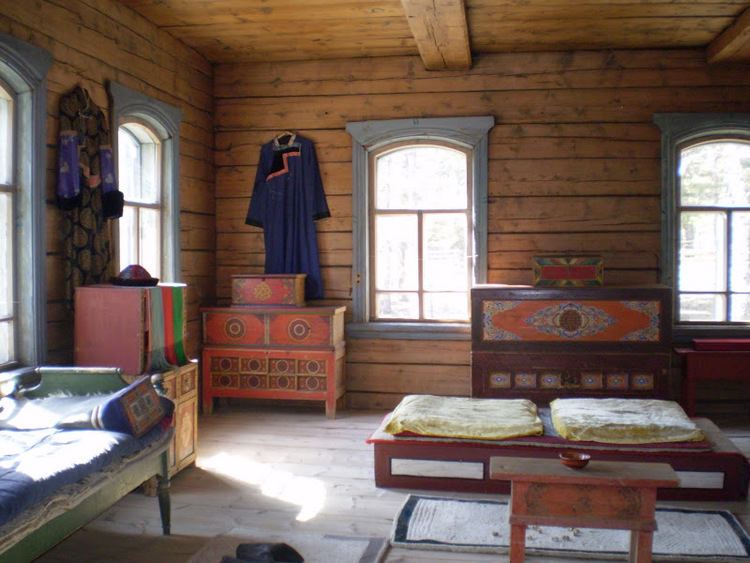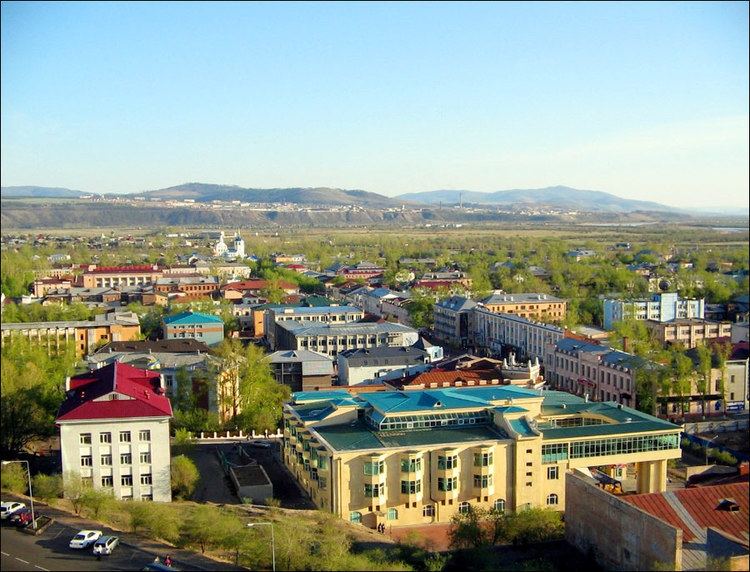Population 404,426 (2010) Capital citation needed Mayor Alexander Golkov | ||
 | ||
Map of Ulan-Ude
Ulan-Ude (Russian: Улан-Удэ; [ʊˈlan ʊˈdɛ]; Buryat: Улаан Үдэ, Ulân Üde) is the capital city of the Republic of Buryatia, Russia; it is located about 100 kilometers (62 mi) southeast of Lake Baikal on the Uda River at its confluence with the Selenga. According to the 2010 Census, 404,426 people lived in Ulan-Ude; up from 359,391 recorded in the 2002 Census, making the city the third largest in eastern Siberia by population.
Contents
- Map of Ulan Ude
- Ulanude investment projects russia
- Names
- Geography
- Hydrography
- History
- Administrative and municipal status
- Demographics
- Transportation
- Culture
- Sights
- Climate
- Notable people
- Twin towns and sister cities
- References
Ulanude investment projects russia
Names

Ulan-Ude was first called Udinskoye (У́динское) for its location on the Uda River. From around 1735, the settlement was called Udinsk (У́динск) and was granted town status under that name in 1775. The name was changed to Verkhneudinsk, literally "Upper Udinsk" (Верхнеу́динск) in 1783, to differentiate it from Nizhneudinsk ("Lower Udinsk") lying on a different Uda River near Irkutsk which was granted town status that year. The "upper" and "lower" refer to positions of the two cities relative to each other, not the location of the cities on their respective Uda rivers. Verkhneudinsk lies at the mouth of its Uda, i.e. the lower end, while Nizhneudinsk is along the middle stretch of its Uda. The current name was given to the city July 27, 1934 and means "red Uda" in Buryat, reflecting the Soviet Union's Communist ideology.
Geography

Ulan-Ude lies 5,640 kilometers (3,500 mi) east of Moscow and 100 kilometers (62 mi) southeast of Lake Baikal. It is 600 meters (2,000 ft) above sea level at the foot of the Khamar-Daban and Khrebet Ulan-Burgasy mountain ranges, next to the confluence of the Selenga River and its tributary, the Uda, which divides the city.

Ulan-Ude is one of the few pairs of cities in the world that has a near-exact antipodal city — with Puerto Natales, Chile.
Hydrography

There are two rivers that flows across Ulan-Ude — Selenga and Uda.
Selenga is the biggest inflow of Baikal Lake, supplying 50% of all rivers in its basin. Selenga brings into the lake about 30 cubic kilometres (7 cubic miles) of water per year, exerting a major influence on the formation of the lake water and its sanitary condition. Selenga is the habitat of the most valuable fish species such as Omul, Siberian sturgeon, Siberian taimen, Thymallus and Coregonus.
Uda is the right inflow of the Selenga river. The length of the watercourse is 467 kilometres (290 miles).
History
The first occupants of the area where Ulan-Ude now stands were the Evenks and, later, the Buryat Mongols. Ulan-Ude was settled in 1666 by the Russian Cossacks as the fortress of Udinskoye. Due to its favorable geographical position, it grew rapidly and became a large trade center which connected Russia with China and Mongolia and, from 1690, was the administrative center of the Transbaikal region. By 1775, it was known as Udinsk, and in 1783 it was granted city status and renamed Verkhneudinsk. After a large fire in 1878, the city was almost completely rebuilt. The Trans-Siberian Railway reached the city in 1900 causing an explosion in growth. The population which was 3,500 in 1880 reached 126,000 in 1939.
From April 6 to October 1920 Verkhneudinsk was the capital of the Far Eastern Republic (Дальневосточная Республика), sometimes called Chita Republic. It was a nominally independent state that existed from April 1920 to November 1922 in the easternmost part of the Russian Far East.
On July 27, 1934, the city was renamed Ulan-Ude.
Administrative and municipal status
Ulan-Ude is the capital of the republic. Within the framework of administrative divisions, it is incorporated as the city of republic significance of Ulan-Ude—an administrative unit with the status equal to that of the districts. As a municipal division, the city of republic significance of Ulan-Ude is incorporated as Ulan-Ude Urban Okrug.
Demographics
According to the 2010 Census, 404,426 people lived in Ulan-Ude; up from 359,391 recorded in the 2002 Census. In terms of population, it is the third largest city in eastern Siberia.
The ethnic makeup of the city's population in 2002:
The city is the center of Tibetan Buddhism in Russia and the important Ivolginsky datsan is located 23 km (14 mi) from the city.
Transportation
Ulan-Ude is located on the main line (Trans-Siberian line) of the Trans-Siberian Railway between Irkutsk and Chita at the junction of the Trans-Mongolian line (the Trans-Mongolian Railway) which begins at Ulan Ude and continues south through Mongolia to Beijing in China. The city also lies on the M55 section of the Baikal Highway (part of the Trans-Siberian Highway), the main federal road to Vladivostok. Air traffic is served by the Ulan-Ude Airport (Baikal), as well as the smaller Ulan-Ude Vostochny Airport. Intracity transport includes tram, bus, and marshrutka (share taxi) lines.
Culture
Until 1991, Ulan-Ude was closed to foreigners. There are old merchants' mansions richly decorated with wood and stone carving in the historical center of Ulan-Ude, along the river banks which are exceptional examples of Russian classicism. The city has a large ethnographic museum which recalls the history of the peoples of the region.
There is a large and highly unusual statue of the head of Vladimir Lenin in the central square: the largest in the world. Built in 1970 for the centennial of Lenin's birth, it towers over the main plaza at 7.7 meters (25 ft) and weighs 42 tons. The head has avoided the patina associated with bronze by a special coating and is a common meeting place.
Other attractions are Geser, a monument, and the King's Gate arch.
Sights
The Ethnographic Museum of the peoples of Transbaikal is one of Russia's largest open-air museums. The museum contains historical finds from the era of the Slab Grave Culture and the Xiongnu until the mid 20th century, including a unique collection of samples of wooden architecture of Siberia - more than forty architectural monuments.
Odigitrievsky Cathedral - Orthodox Church Diocese of the Buryat, was the first stone building in the city and is a Siberian baroque architectural monument. The cathedral is considered unique because it is built in a zone of high seismic activity in the heart of the city on the banks of the River Uda River where it flows into the Selenga.
One of the attractions of Ulan-Ude is a monument in the town square — the square of the Soviets — in the form of the head of Lenin (sculptors G.V. Neroda, J.G. Neroda, architects Dushkin, P.G. Zilberman). The monument, weighing 42 tons and with a height of 7.7 meters (25 ft), was opened in 1971 in honor of the centenary of Lenin's birth.
Climate
Ulan-Ude can be described as possessing a very continental steppe climate (Köppen climate classification BSk), bordering on a humid continental climate (Dwb). The climate is characterised by long, dry, cold winters and short but very warm summers. Precipitation is low and heavily concentrated in the warmer months.
Notable people
Twin towns and sister cities
Ulan-Ude is twinned with:
